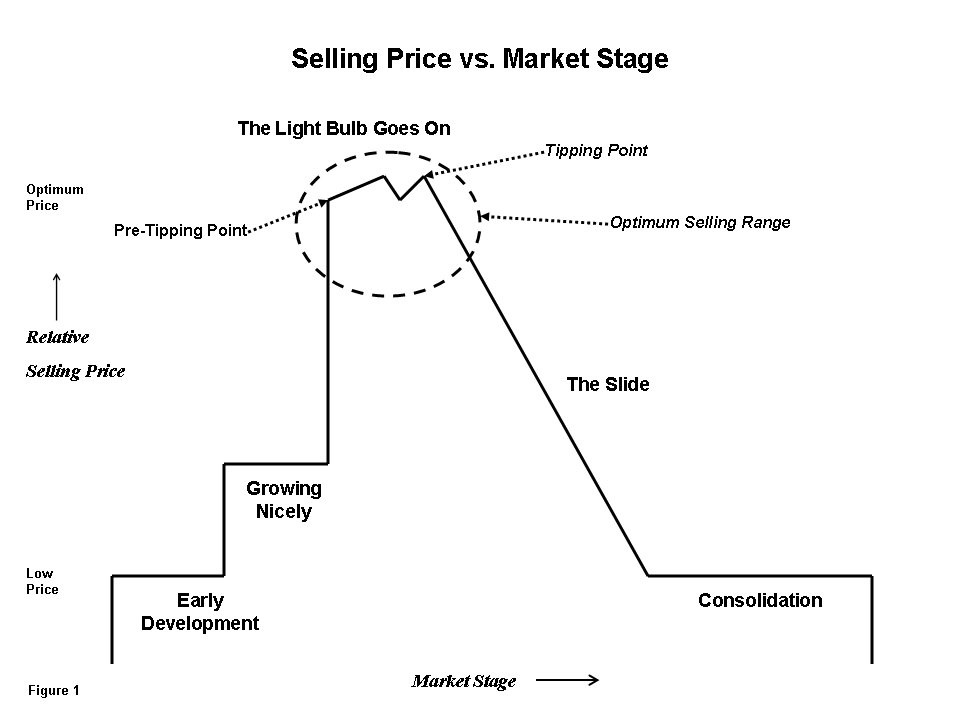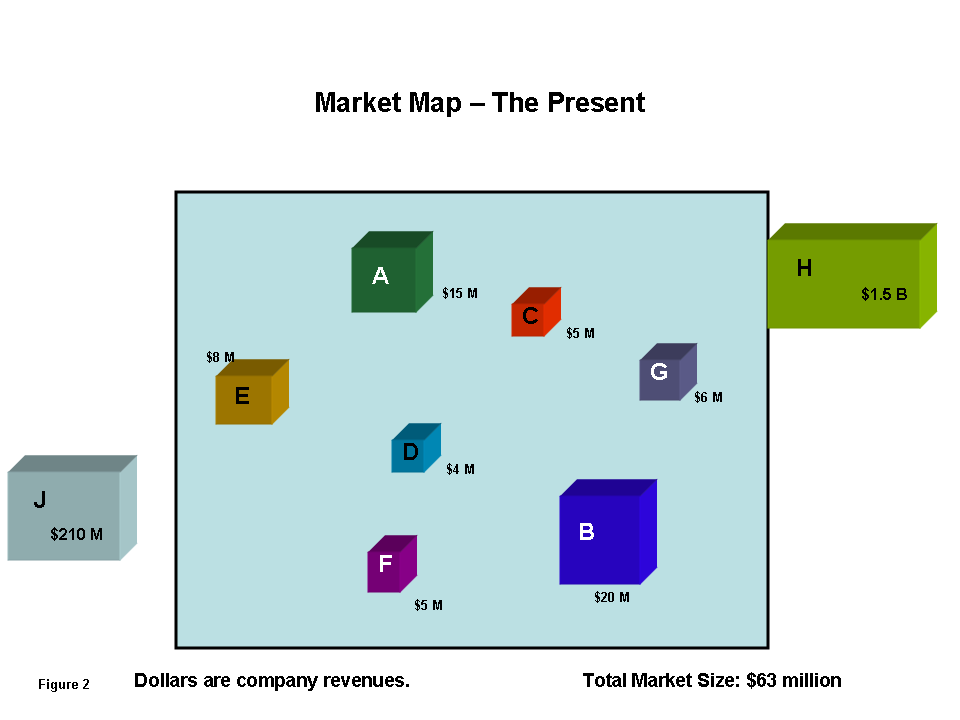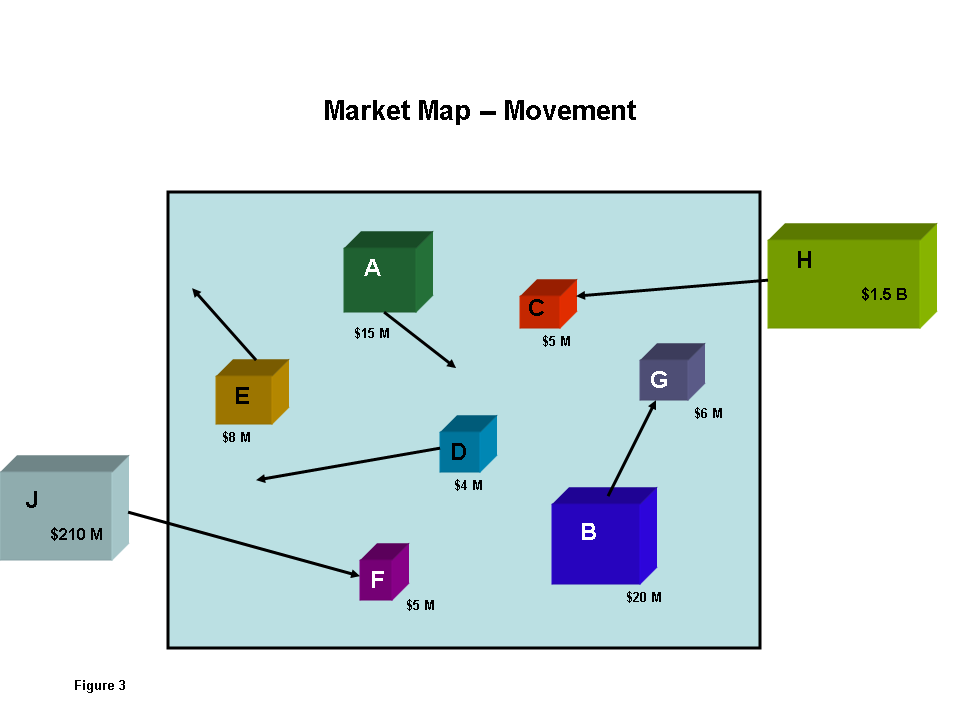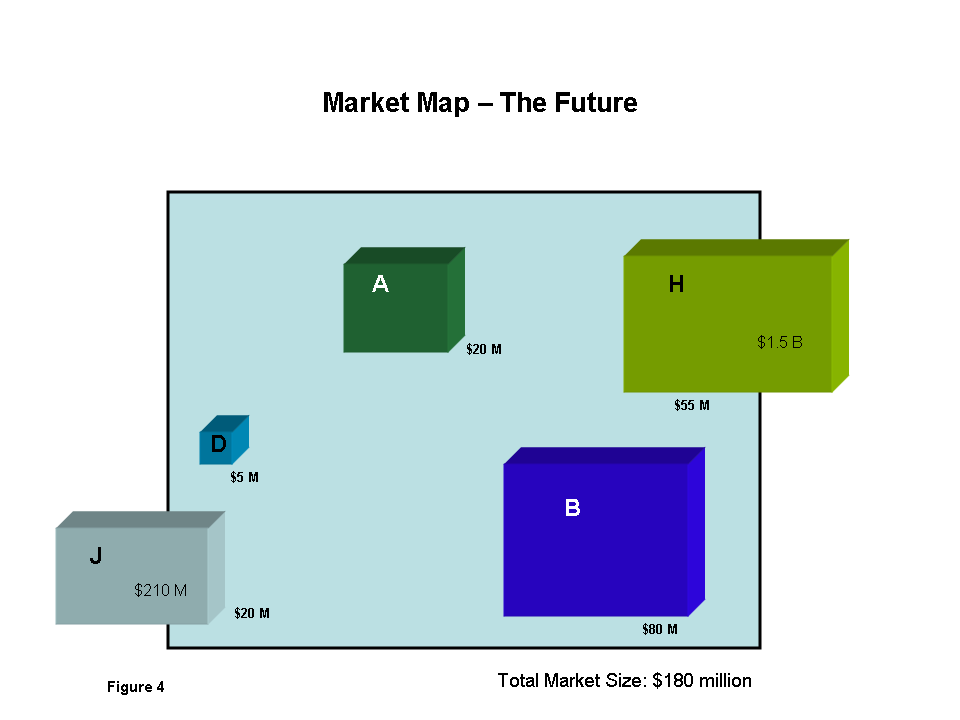Optimum
Price vs. Market Stage
Recognizing
the pre-tipping
point of a market space is critical if a company wants to sell for the
optimum price. Why is this important? Because market timing is the
primary driver of price when selling a company. Whether it is a high
price, medium price or low price, the market timing has more influence
than any other factor.
The market may
be on a different time schedule than your company's
growth curve. If a company waits to sell until its revenues have
peaked, there may be little growth left in the company. The company has
maxed out. Buyers will realize this and will not pay top dollar. Paying
attention to the reality of the market is not only a good survival
skill, it is the primary requisite for realizing the optimum price.
The best time
to sell is when the big companies
decide to move into a
market. That is when they are willing to pay top dollar. Large
companies need to acquire technology, market knowledge and expertise in
a hurry. They want to acquire the technology, rather than develop their
own technology in order to make a speedy market entry. They also need
to acquire a company that has a team of people that understands the
market, the customers and the customers' issues.
Large
companies are rarely early movers into a new
market. Big
companies want to go into big markets, not small markets. New markets
are almost always small markets. So, until a market has clearly
demonstrated that it will be big, the large companies sit on the
sidelines and wait until they are sure that the market will be
significant. Once these larger companies do decide to move, the
pre-tipping point is at hand. Now the clock begins to tick and the
tipping point is not far behind.
Why the
pre-tipping point? Because if you wait for
the tipping point,
it will be too late. The biggest exit mistake that technology companies
make is that they decide to sell too late in the game. They want to
sell when the company has peaked. The problem is that this is usually
unrelated to market timing. This is an internal focus and an internal
focus rarely leads to the highest price. Many technology executives
ignore market timing. The highest value is achieved by looking
externally and capitalizing on the optimal market situation.
Market
Stages
The life cycle of a market consists of several
stages that are
typically illustrated by a graph showing industry revenues over time.
These stages are introduction, growth, maturity and decline. A similar
graph can illustrate the best time to sell. However, instead of the
vertical axis representing total revenues, it represents the relative
selling price of acquisitions. It is critical for a selling company to
view the market stages from this viewpoint—from the perspective of how
much a buyer is likely to pay. The stages break out like this:
- Early Development
- Growing Nicely
- The Light Bulb Goes
On
- The Slide
- Consolidation
Early
Development
In the Early
Development stage a number of smaller companies are
developing technology and scrambling to get customers. The market is
new, so there are not any medium-sized companies yet. The large
acquirers don't yet know if this market will be a significant market.
If a buyer is willing to make an acquisition at all, it will be for a
moderate price at best. Medium-sized buyers are the only buyers at this
stage because small acquisitions of less than $20 million are
meaningful to them. These buyers are situated on the edge of the market
or in an adjacent market, not in the core market.

[Click to
enlarge]
Growing
Nicely
Small
companies are expanding from $5 million in revenue to $20 million
in revenue. At this stage an intelligent buyer will pay a good price
for technology and people who have a familiarity with the market.
However, most large buyers will not make acquisitions at this stage.
They will wait until it is proven that the market is large before
moving in.
One of the
problems with the Growing Nicely stage is that most smaller
companies prefer to continue building on their own rather than be
acquired. They think the timing is premature. Most entrepreneurs are
quite independent and the idea of selling early is anathema.
Discrepancies
can arise between the goals of the entrepreneur and the
objectives of the shareholders. The company must be clear what its
goals are—to build a business and stay independent (sometimes at all
costs) or to build a business and sell at the optimal time.
If a company
is growing nicely, it usually wants to continue down this
path. The entrepreneur and his team are doing well and having fun. They
have overcome hurdles and obstacles. It feels good to be growing
nicely. They want to continue enjoying the ride. The last thing they
want to do is to sell. They view selling as "game over." If they were
to consider selling, it would be after just one more good quarter of
revenue, one more new product release, one more industry trade show,
etc. There is always something.
An ironic
situation can occur at this point. A second tier company may
not be growing quite as nicely as the company described above. It may
be having difficulty making headway in the market so it decides to sell
to a larger company on the periphery of the market. Now the second tier
player has access to the financial strength and the sales and
distribution capabilities to make major inroads. Their technology may
not be the best, but with strong sales and marketing power they can be
a potent force in the market.
The Light Bulb Goes
On
At the Light
Bulb stage the big companies finally get it. They
recognize that the market will be substantial in size. They make
acquisitions and are willing to pay top dollar.
Acquisitions
are the best way to grab a foothold in a short time
period. Competitive pressures dictate that they participate in this
market, so they follow each other into the market. They do not want to
be left out. Even a company on the edge of the market who is not a
major player may make an acquisition in order to procure software or
technology that can be part of their overall product solution.
The apex of
the graph represents the point in time when the first large
company makes an acquisition to enter the core market. This is the
pre-tipping point. A second company will soon follow with another
acquisition. Companies are realizing that this will be an emerging and
vital market. Sometimes a third company joins the fray. Rarely,
however, will there be more than three big players making acquisitions
at this stage. Sometimes a major player will make several acquisitions.
The first small or medium-sized company to sell often obtains the best
price, a kind of “first seller advantage.”
The Slide
The Slide
begins after the tipping point, after the large players have
moved in. The only reason an acquisition would be made during the Slide
phase is if a large company chose to acquire a medium-sized company in
order to add mass and shore up some of its product offerings. In this
phase the big companies are firming up U.S. operations and possibly
moving into a few foreign markets. The acquisition of an overseas
company is about the only good possibility in this stage. The large
companies have already made their acquisitions and any remaining
smaller players must settle for a smaller piece of pie.
Consolidation
In the
Consolidation phase buyers will make acquisitions primarily to
add customers. The price will not be a high one. Buyers do not need to
acquire technology or engineering teams because they already have their
own teams and technology. Even if a smaller company has truly better
software or technology, the costs of switching are too high to make an
acquisition attractive. A buyer may seek to acquire a company in a new
geographic location. Almost all acquisitions made in the Consolidation
phase are motivated by a desire to add to the customer base.
Mapping the Market
Market maps
are an excellent way to visually represent the state of the
market and the movement of that market. There are three states: the
present state, the movement and the future state. What can we learn
from looking at these diagrams?

[Click
to enlarge]
The
Present
This market
map depicts the present market situation, typically
consisting of a handful of small players. The technology is not cast in
concrete; no standards have been set. There are no big companies
because the market is too new and too small for them. However, there
are a few big companies in adjacent markets who are keeping an eye on
the pace of growth in this new market.
Many CEOs have
a myopic viewpoint, focusing only on their core market.
Their viewpoint is black and white—a buyer is regarded as either in
their market or not in their market. However, the gray edges of the
market and the adjacent markets can be fertile areas for good acquirers.
Movement
The Market
Movement Map is a dynamic map illustrating the movement of
companies into the market, making acquisitions, as well as companies
moving away from the core. This is where the market begins to morph.
Some companies are moving in, some are making acquisitions, and some
are doing both. A big company in an adjacent market is making an
acquisition. A smaller firm is moving toward the edge of the market,
deciding to focus on a particular vertical niche rather than cater to
the market as a whole.
Many companies
do not see this picture very clearly. The management
teams are busy running their companies and have their heads down,
focused on developing technology and selling product. Their focus is
operational, trying to “peddle faster,” rather than thinking about the
broader strategic picture.

[Click
to enlarge]
Medium-sized
companies rarely make acquisitions during this morphing
phase. The likely target companies are their competitors and they may
not particularly like them. They think their own technology is superior
so why would they acquire another company?
Market
bitterness may also play a role. They may have lost sales to a
competitor or heard remarks at a trade show that the competitor was
badmouthing them. These reasons may seem petty but they inhibit a
growing company from seeking an acquisition. So, they choose to grow
only organically. The downside is that a bigger company in an adjacent
market can acquire a small player and very rapidly gain a strong market
position, sometimes eclipsing the medium-sized company that was doing
fairly well in the market originally. The lesson here is—when the
market begins to morph, when the big players begin to move, a
medium-sized firm needs to take action and make an acquisition in order
to grab a bigger piece of the market. A smaller company should seek to
acquire or to be acquired or it will be left to languish.
The Future
The Future
Market Map looks almost exactly the same for most market
sectors. There will be one or two market leaders and one third-place
company. If a fourth or a fifth company exists, it will be small and
will not be particularly profitable.
There are a
few other observations to make from the market maps. Notice
that Company A does not make an acquisition. It grows from $15 million
to $20 million, which is respectable, but now it is a third place
player. Company H and Company B have grown through acquisitions and
have eclipsed Company A. Notice that this market has tripled in size
from $60 million to $180 million in total revenues and is still
growing. What started out as an insignificant market is now a very
respectable market.
[Click to
enlarge]
Recognizing
the Pre-tipping Point
The first
major sign that the pre-tipping point has been reached is
when one of the large companies makes an acquisition in the core market
space. Large is a relative term—it could be a $1 billion revenue
company or it could be a $200 million revenue company. It depends on
the market, the size of the market and the relative size of the
companies in that market.
When a second
large company makes an acquisition in the space, it is
time to get moving. The tipping point is near at hand. The time period
between the first acquisition and the second acquisition could be
short, within six months or maybe a little longer, up to 18 months. But
rarely is the second acquisition any farther down the road than that.
A good example
of the pre-tipping point is the online
advertising industry. Google recently bought Double Click for $3.2
billion. A month later Microsoft acquired aQuantive inc. (which owns
Avenue A and Razorfish) for $6 billion. This deal was disclosed less
than 24 hours after WPP Group's $649 million acquisition of 24/7 Real
Media. In the time span of less than two months the three major players
have made three acquisitions. The tipping point is now at hand.
Another clue
is when a large company develops technology internally in
order to enter a new market space. If this is the case, articles and
news releases will report about the company's move into the market
sector. For example, Microsoft developed its own software for its music
player, Zune.
A large
company may contact you out of the blue about acquiring your
company. Do not dismiss the idea too readily. It may be the right
market time. If a big company has acquired, or is acquiring, one of
your competitors, it may be wise to be proactive and explore a sale to
another large competitor.
Summary
If a company
wants to sell for the optimum price, the best thing it can
do is pay attention to the stage of the market. This goes against the
instincts of may tech people who are overly focused on their own
technology. The stage of the market is the primary driver for realizing
the optimum price for the sale of a company.
|


